Luminous Read online
Page 6
‘Mmm nnn,’ I conceded.
I’d been ready to denounce both sides, resign from the EPR project – and even walk away from Lena, if it came to that.
Maybe it was more pride than love, more weakness than commitment, more inertia than loyalty. Whatever the reason, though, I couldn’t do it. I couldn’t leave her.
The only way forward was to try to finish what I’d started. To give the Children their watertight, absolute proof.
* * *
While the rival ancestor cults picketed and fire-bombed each other, rivers of blood flowed through my apparatus. The Children had supplied me with two-litre samples from no fewer than 50,000 members, worldwide; my lab would have put the most garish Hammer Horror film set to shame.
Trillions of plasmids were analysed. Electrons in a certain low-energy hybrid orbital – a quantum mixture of two different-shaped charge distributions, potentially stable for thousands of years – were induced by finely tuned laser pulses to collapse into one particular state. And though every collapse was random, the orbital I’d chosen was – very slightly – correlated across paired strands of DNA. Quadrillions of measurements were accumulated, and compared. With enough plasmids measured for each individual, the faint signature of any shared ancestry could rise up through the statistical noise.
The mutations behind the Children’s Great Tree no longer mattered; in fact, I was looking at stretches of the plasmid most likely to have stayed unblemished all the way back to Eve, since it was the intimate chemical contact of flawless DNA replication which gave the only real chance of a correlation. And as the glitches in the process were ironed out, and the data mounted up, results finally began to emerge.
The blood donors included many close family groups; I analysed the data blind, then passed the results to one of my research assistants, to be checked against the known relationships. Early in June 2013, I scored 100 per cent on sibling detection in a thousand samples; a few weeks later, I was doing the same on first and second cousins.
Soon, we hit the limits of the recorded genealogy; to provide another means of cross-checking, I started analysing nuclear genes as well. Even distant cousins were likely to have at least some genes from a common ancestor – and EPR could date that ancestor precisely.
News of the project spread, and I was deluged with crank mail and death threats. The lab was fortified; the Children hired bodyguards for everyone involved in the work, and their families.
The quantity of information just kept growing, but the Children, horrified by the thought that the Adams might outdo them with rival technology, kept voting me more and more money. I upgraded our supercomputers, twice. And though mitochondria alone could lead me to Eve, for bookkeeping purposes I found myself tracing the nuclear genes of hundreds of thousands of ancestors, male and female.
In the spring of 2016, the database reached a kind of critical mass. We hadn’t sampled more than the tiniest fraction of the world’s population, but once it was possible to reach back just a few dozen generations all the apparently separate lineages began to join up. Autosomal nuclear genes zigzagged heedlessly between the purely maternal tree of the Eves and the purely paternal tree of the Adams, filling in the gaps … until I found myself with genetic profiles of virtually everyone who’d been alive on the planet in the early ninth century (and left descendants down to the present). I had no names for any of these people, or even definite geographical locations, but I knew, precisely, the place of every one of them on my own Great Tree.
I had a snapshot of the genetic diversity of the entire human species. From that point on there was no stopping the cascade, and I pursued the correlations back through the millennia.
* * *
By 2017, Lena’s worst predictions had all come true. Dozens of different Adams had been proclaimed around the world, and the trend was to look for the common paternal lineage of smaller and smaller populations, converging on ever more recent ancestors. Many were now supposedly historical figures; rival Greek and Macedonian groups were fighting it out over who had the right to call themselves the Sons of Alexander the Great. Y-chromosomal ethnic classification had become government policy in three eastern European republics and, allegedly, corporate policy in certain multinationals.
The smaller the populations analysed, of course – unless they were massively inbred – the less likely it was that everyone targeted really would share a single Adam. So the first male ancestor to be identified became ‘the father of his people’ …
and anyone else became a kind of gene-polluting barbarian rapist, whose hideous taint could still be detected. And weeded out.
Every night I lay awake into the early hours, trying to understand how I could have ended up at the centre of so much conflict over something so idiotic. I still couldn’t bring myself to confess my true feelings to Lena, so I’d pace the house with the lights out, or lock myself in my study with the bulletproof shutters closed and sort through the latest batch of hate mail – paper and electronic – hunting for evidence that anything I might discover about Eve would have the slightest positive effect on anyone who wasn’t already a fanatical supporter of the Children. Hunting for some sign that there was hope of ever doing more than preaching to the converted.
I never did find the encouragement I was looking for, but there was one postcard which cheered me up, slightly. It was from the High Priest of the Church of the Sacred UFO, in Kansas City.
Dear Earth-dweller:
Please use your BRAIN! As anyone KNOWS in this SCIENTIFIC age, the origin of the races is now WELL UNDERSTOOD! Africans travelled here after the DELUGE from Mercury, Asians from Venus, Caucasians from Mars, and the people of the Pacific islands from assorted asteroids. If you don’t have the NECESSARY OCCULT SKILLS to project rays from the continents to the ASTRAL PLANE to verify this, a simple analysis of TEMPERAMENT and APPEARANCE should make this obvious even to YOU!
But please don’t put WORDS into MY mouth! Just because we’re all from different PLANETS doesn’t mean we can’t still be FRIENDS.
* * *
Lena was deeply troubled. ‘But how can you hold a media conference tomorrow, when Cousin William hasn’t even seen the final results?’ It was Sunday, 28 January 2018. We’d said goodnight to the bodyguards and gone to bed in the reinforced concrete bunker the Children had installed for us after a nasty incident in one of the Baltic States.
I said, ‘I’m an independent researcher. I’m free to publish data at any time. That’s what it says in the contract. Any advances in the measurement technology have to go through the Children’s lawyers, but not the palaeogenetic results.’
Lena tried another tack. ‘But if this work hasn’t been peer-reviewed—’
‘It has. The paper’s already been accepted by Nature; it will be published the day after the conference. In fact,’ I smiled innocently, ‘I’m really only doing it as a favour to the editor. She’s hoping it will boost sales for the issue.’
Lena fell silent. I’d told her less and less about the work over the preceding six months; I’d let her assume that technical problems were holding up progress.
Finally she said, ‘Won’t you at least say if it’s good news – or bad?’
I couldn’t look her in the eye, but I shook my head. ‘Nothing that happened 200,000 years ago is any kind of news at all.’
* * *
I’d hired a public auditorium for the media conference – far from the Children’s office tower – paying for it myself, and arranging for independent security. Sachs and his fellow directors were not impressed, but short of kidnapping me there was little they could do to shut me up. There’d never been any suggestion of fabricating the results they wanted – but there’d always been an unspoken assumption that only the right data would ever be released with this much fanfare – and the Children would have ample opportunity to put their own spin on it, first.
Behind the podium, my hands were shaking. Over two thousand journalists from across the planet had turned up, a
nd many of them were wearing symbols of allegiance to one ancestor or another.
I cleared my throat and began. The EPR technique had become common knowledge; there was no need to explain it again. I said, simply, ‘I’d like to show you what I’ve discovered about the origins of Homo sapiens.’
The lights went down and a giant hologram, some thirty metres high, appeared behind me. It was, I announced, a family tree – not a rough history of genes or mutations, but an exact generation-by-generation diagram of both female and male parentage for the entire human population – from the ninth century, back. A dense thicket in the shape of an inverted funnel. The audience remained silent, but there was an air of impatience; this tangle of a billion tiny lines was indecipherable – it told them absolutely nothing. But I waited, letting the impenetrable diagram rotate once, slowly.
‘The Y-chromosome mutational clock,’ I said, ‘is wrong. I’ve traced the paternal ancestries of groups with similar Y-types back hundreds of thousands of years – and they never converge on any one man.’ A murmur of discontent began; I boosted the amplifier volume and drowned it out. ‘Why not? How can there be so little mutational diversity if the DNA doesn’t all spring from a single, recent source?’ A second hologram appeared, a double-helix, a schematic of the Y-typing region. ‘Because mutations happen, again and again, at exactly the same sites. Make two, or three – or fifty – copying errors in the same location, and it still only looks like it’s one step away from the original.’ The double helix hologram was divided and copied, divided and copied; the accumulated differences in each generation were highlighted. ‘The proof-reading enzymes in our cells must have specific blind spots, specific weaknesses – like words that are easy to misspell. And there’s still a chance of purely random errors, at any site at all, but only on a time scale of millions of years.
‘All the Y-chromosome Adams,’ I said, ‘are fantasy. There are no individual fathers to any race, or tribe, or nation. Living northern Europeans, for a start, have over a thousand distinct paternal lineages dating to the late Ice Age – and those thousand ancestors, in turn, are the descendants of over two hundred different male African migrants.’ Colours flashed up in the grey maze of the Tree, briefly highlighting the lineages.
A dozen journalists sprang to their feet and started shouting abuse. I waited for the security guards to escort them from the building.
I looked out across the crowd, searching for Lena, but I couldn’t find her. I said, ‘The same is true of mitochondrial DNA. The mutations overwrite themselves; the molecular clock is wrong. There was no Eve 200,000 years ago.’ An uproar began, but I kept talking. ‘Homo erectus spread out of Africa – dozens of times, over two million years, the new migrants always interbreeding with the old ones, never replacing them.’ A globe appeared, the entire Old World so heavily decorated with criss-crossing paths that it was impossible to glimpse a single square kilometre of ground. ‘Homo sapiens arose everywhere, at once – maintained as one species, worldwide, partly because of migrant gene flow and partly thanks to the parallel mutations which invalidate all the clocks: mutations taking place in a random order, but biased towards the same sites.’ A hologram showed four stretches of DNA, accumulating mutations; at first, the four strands grew increasingly dissimilar, as the sparse random scatter struck them differently, but as more and more of the same vulnerable sites were hit they all came to bear virtually the same scars.
‘So modern racial differences are up to two million years old – inherited from the first Homo erectus migrants – but all of the subsequent evolution has marched in parallel, everywhere … because Homo erectus never really had much choice. In a mere two million years, different climates could favour different genes for some superficial local adaptations, but everything leading to Homo sapiens was already latent in every migrant’s DNA before they left Africa.’
There was a momentary hush from the Eve supporters – maybe because no one could decide any more whether the picture I was painting was unifying or divisive. The truth was just too gloriously messy and complicated to serve any political purpose at all.
I continued. ‘But if there was ever an Adam or an Eve, they were long before Homo sapiens, long before Homo erectus. Maybe they were … Australopithecus?’ I displayed two stooped, hairy, ape-like figures. People started throwing their video cameras. I hit a button under the podium, raising a giant Perspex shield in front of the stage.
‘Burn all your symbols!’ I shouted. ‘Male and female, tribal and global. Give up your Fatherlands and your Earth Mothers – it’s Childhood’s End! Desecrate your ancestors, screw your cousins – just do what you think is right because it’s right.’
The shield cracked. I ran for the stage exit.
The security guards had all vanished, but Lena was sitting in our armour-plated Volvo in the basement car park, with the engine running. She wound down the mirrored side window.
‘I watched your little performance on the net.’ She gazed at me calmly, but there was rage and pain in her eyes.
I had no adrenaline left, no strength, no pride; I fell to my knees beside the car. ‘I love you. Forgive me.’
‘Get in,’ she said. ‘You’ve got a lot of explaining to do.’
LUMINOUS
I woke, disorientated, unsure why. I knew I was lying on the narrow, lumpy single bed in Room 22 of the Hotel Fleapit; after almost a month in Shanghai, the topography of the mattress was depressingly familiar. But there was something wrong with the way I was lying; every muscle in my neck and shoulders was protesting that nobody could end up in this position from natural causes, however badly he’d slept.
And I could smell blood.
I opened my eyes. A woman I’d never seen before was kneeling over me, slicing into my left tricep with a disposable scalpel. I was lying on my side, facing the wall, one hand and one ankle cuffed to the head and foot of the bed.
Something cut short the surge of visceral panic before I could start stupidly thrashing about, instinctively trying to break free. Maybe an even more ancient response – catatonia in the face of danger – took on the adrenaline and won. Or maybe I just decided that I had no right to panic when I’d been expecting something like this for weeks.
I spoke softly, in English. ‘What you’re in the process of hacking out of me is a necrotrap. One heartbeat without oxygenated blood, and the cargo gets fried.’
My amateur surgeon was compact, muscular, with short black hair. Not Chinese; Indonesian, maybe. If she was surprised that I’d woken prematurely, she didn’t show it. The gene-tailored hepatocytes I’d acquired in Hanoi could degrade almost anything from morphine to curare; it was a good thing the local anaesthetic was beyond their reach.
Without taking her eyes off her work, she said, ‘Look on the table next to the bed.’
I twisted my head around. She’d set up a loop of plastic tubing full of blood – mine, presumably – circulated and aerated by a small pump. The stem of a large funnel fed into the loop, the intersection controlled by a valve of some kind. Wires trailed from the pump to a sensor taped to the inside of my elbow, synchronising the artificial pulse with the real. I had no doubt that she could tear the trap from my vein and insert it into this substitute without missing a beat.
I cleared my throat and swallowed. ‘Not good enough. The trap knows my blood-pressure profile exactly. A generic heartbeat won’t fool it.’
‘You’re bluffing.’ But she hesitated, scalpel raised. The handheld MRI scanner she’d used to find the trap would have revealed its basic configuration, but few fine details of the engineering – and nothing at all about the software.
‘I’m telling you the truth.’ I looked her squarely in the eye, which wasn’t easy given our awkward geometry. ‘It’s new, it’s Swedish. You anchor it in a vein forty-eight hours in advance, put yourself through a range of typical activities so it can memorise the rhythms … then you inject the cargo into the trap. Simple, fool-proof, effective.’ Blood trickled down across my chest on
to the sheet. I was suddenly very glad that I hadn’t buried the thing deeper, after all.
‘So how do you retrieve the cargo, yourself?’
‘That would be telling.’
‘Then tell me now, and save yourself some trouble.’ She rotated the scalpel between thumb and forefinger impatiently. My skin did a cold burn all over, nerve ends jangling, capillaries closing down as blood dived for cover.
I said, ‘Trouble gives me hypertension.’
She smiled down at me thinly, conceding the stalemate, then peeled off one stained surgical glove, took out her notepad, and made a call to a medical-equipment supplier. She listed some devices which would get around the problem – a blood-pressure probe, a more sophisticated pump, a suitable computerised interface – arguing heatedly in fluent Mandarin to extract a promise of a speedy delivery.
Then she put down the notepad and placed her ungloved hand on my shoulder. ‘You can relax now. We won’t have long to wait.’
I squirmed, as if angrily shrugging off her hand, and succeeded in getting some blood on her skin. She didn’t say a word, but she must have realised at once how careless she’d been; she climbed off the bed and headed for the washbasin, and I heard the water running.
Then she started retching.
I called out cheerfully, ‘Let me know when you’re ready for the antidote.’
I heard her approach, and I turned to face her. She was ashen, her face contorted with nausea, eyes and nose streaming mucus and tears.

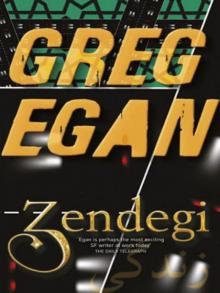 Zendegi
Zendegi Permutation City
Permutation City The Eternal Flame
The Eternal Flame Artifacts
Artifacts Wang's Carpets
Wang's Carpets Dichronauts
Dichronauts Incandescence
Incandescence Teranesia
Teranesia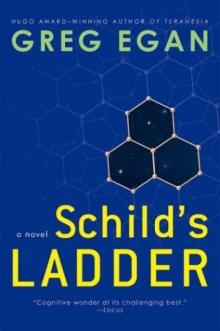 Schild's Ladder
Schild's Ladder Quarantine
Quarantine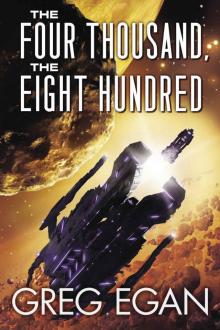 The Four Thousand, the Eight Hundred
The Four Thousand, the Eight Hundred The Clockwork Rocket
The Clockwork Rocket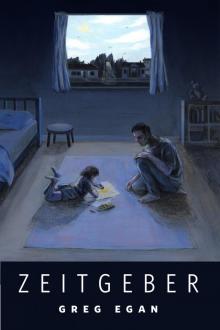 Zeitgeber
Zeitgeber Phoresis
Phoresis The Nearest
The Nearest Diaspora
Diaspora Instantiation
Instantiation Distress
Distress An Unusual Angle
An Unusual Angle Oceanic
Oceanic The Arrows of Time
The Arrows of Time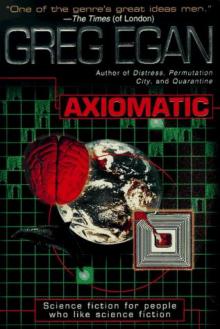 Axiomatic
Axiomatic![Anthology 2. Luminous [1998, 2010] Read online](http://i1.bookreadfree.com/i/03/18/anthology_2_luminous_1998_2010_preview.jpg) Anthology 2. Luminous [1998, 2010]
Anthology 2. Luminous [1998, 2010] Perihelion Summer
Perihelion Summer Luminous
Luminous